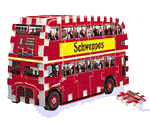Double Decker Bus

test
On February 8, 1956, the world's most recognizable bus entered service. Although no one denied the quality of the features that would go on to standardize London's double-decker fleet, several people were disappointed with the conventional pre-war design. The RM1 was 8 feet ( 2 m) wide, 27 feet (8 m) long and 14 feet (4 m) tall. The engine and driver cab were located at the front, while a rear platform enabled the passengers to circulate. Stairs led to the upper deck of the bus. A ticket inspector posted at the rear collected the fare and ensured passengers climbed aboard and got off safely. In the early 1960s, more than 2,800 open-topped buses were on the road in London. Today, roughly 500 Routemasters continue to serve the city's gridlocked downtown area.
